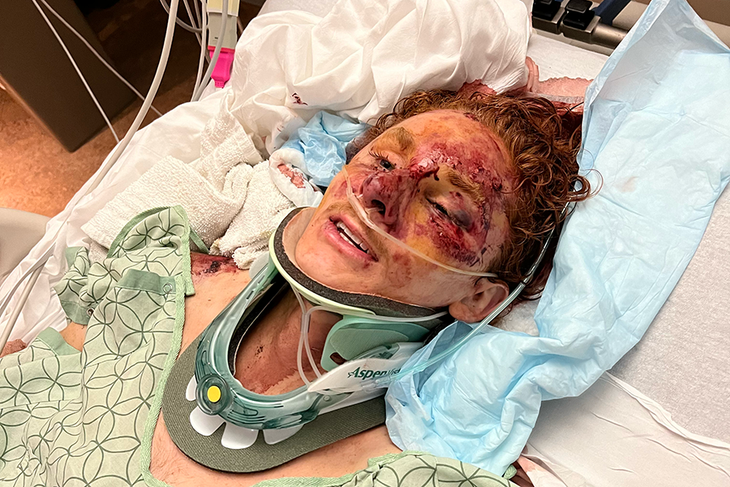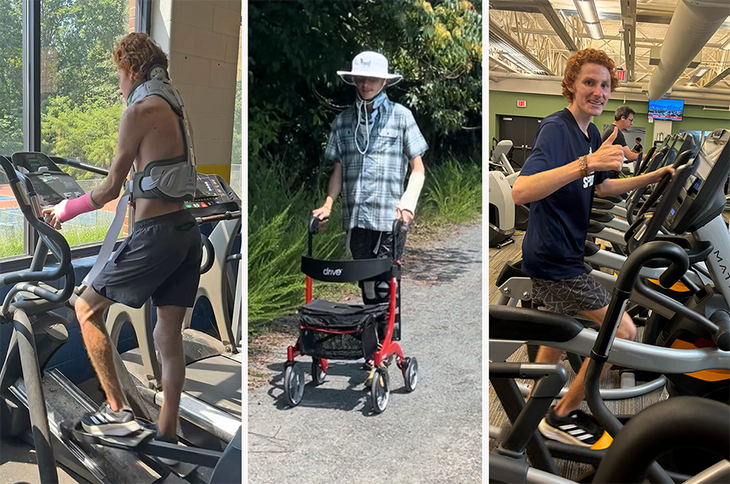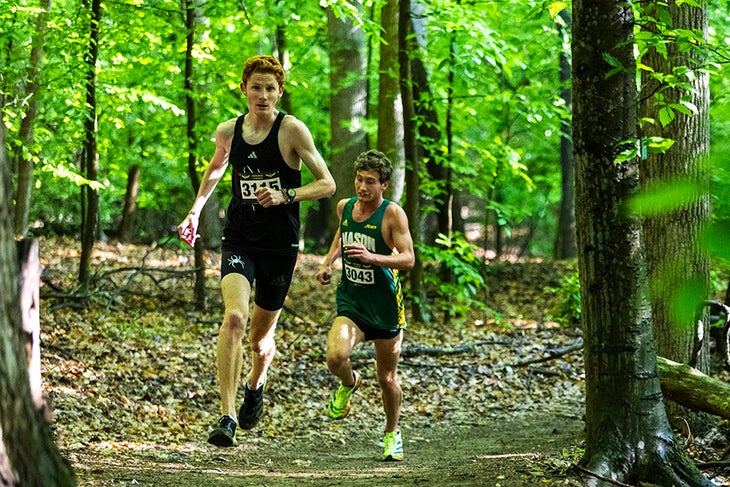Stuart Terrill’s life forever changed in a blink of an eye during a competitive mountain running race this past summer.
On July 13, the 22-year-old from Crozet, Virginia, summited 11,000-foot Hidden Peak at Snowbird ski resort above Salt Lake City. He was an hour into the 8.7-mile serving double duty as the 2024 USA Track and Field Mountain Running Championships.
Terrill had just graduated from the University of Richmond, where he ran cross country and track and double-majored in leadership and communication. But he was no stranger to the trails. He won the in Fairfax, Virginia, in May, besting the competition by nearly a minute over the 10K course to earn his second straight collegiate trail running championship title.
As he crested Hidden Peak and started bombing down the other side, Terrill passed a competitor and lost control, sending him careening towards a cliff. Photographer Matt Johnson watched in horror, pivoting to try to catch Terrill before he fell. But he was too late. Terrill toppled over the edge and tumbled more than 200 feet down the jagged unforgiving terrain below.
“He swung wide to pass a runner. His momentum sent him barreling down towards me and I dropped my camera to try and grab him,” Johnson recalled in the resort’s incident report. “I heard his terrified screams as he went out of sight down the rocky gully. At this point I screamed for a medic and life flight because I wasn’t sure if he was going to even survive. It was rough. It was one of the most horrifying things I’ve ever witnessed.
Terrill suffered numerous broken bones—eight vertebrae, four ribs, his right collarbone, left wrist, right kneecap, and several bones in each of his feet—and was lucky to be alive. As his mangled body was taken away in a medical helicopter, all those on the scene could do was wonder: how did such a perilous accident happen?
In its safety advisories on its website and in emails to participants, the event warns that “it is imperative, for your safety, you follow precise path of flagging.” Terrill’s fall was not the result of a course-marking issue. He simply made a risky passing move at an unfortunate spot on the course.
“We are very familiar with the exact spot of his accident,” said Julian Carr, the race director of the Cirque Series. “We will place people as backstop in that exact corner to ensure no one ever has a fall in that spot ever again.”

Mountain Running: A Contact Sport?
While many may be initially attracted to running (on the track and roads) precisely because of its relatively low-risk profile—no contact that could lead to a concussion, no explosive movements that could result in an acute injury—trail running, and in particular mountain running, is another matter. In fact, mountain running, a fast, explosive trail running discipline that usually involves running over rocky, uneven terrain and climbing and descending peaks, comes with considerable risk.
Many mountain running races take competitors along high cliffs and ridgelines with exposure, and down steep, off-trail descents through technical terrain. Minor falls are common, and sprained ankles, broken collarbones, and skin-devouring trail rash are among the most typical injuries.
Injuries are common enough that some races, including the Pikes Peak Marathon in Manitou Springs, Colorado, give out an award for the bloodiest runner. , a short mountain race in Seward Alaska, reports several minor injuries in a typical year. In 2012, it suffered its first presumed death when 66-year-old Michael LeMaitre, fell on a steep section of the course and, inexplicably, was never found.
Although it wasn’t a super-fast shorter-distance mountain running race, American runner survived one of the worst known trail running accidents in 2017 at the 57K Hamperokken Skyrace in the mountains outside of Tromso, Norway, after she tripped and ragdolled 150 feet down a ridge and broke both arms, two vertebrae, several ribs, and numerous bones in her feet. Like Terrill, she was lucky to have survived.
“We acknowledge the inherent dangers of producing races in the high alpine, injuries are rare, but do happen unfortunately,” Carr says. “This is, by far, the most serious injury at a Cirque race since we started our races in 2015. We take safety of our runners as first priority.”
Mountain running races bring on increased danger for highly competitive athletes, especially because the terrain is often extremely technical, varies so greatly, and is often raced sight-unseen. In addition, elite runners are often willing to take risks on high-consequence terrain that is the difference between performing well and getting left in the dust of those who do.
Is this risk taking an allure or a consequence of the sport? And what level of responsibility do race organizers play in keeping competitors safe?
Carr says the event’s emergency response plan is an integral part of planning and preparing for the event and it begins well in advance of race day.
“We put a lot of thought into our safety maps,” Carr says. “When we mark the course, I chat with our safety director about optimal EMT, patrol, and volunteer placements throughout the day. Once we finish marking course, we have a meeting to determine all safety personnel placements for the race. Then we generate the safety map. We provide digital copies and printed copies to all safety personnel for race day.”
Brendan Madigan, who operates the Broken Arrow Skyrace at Palisades Tahoe ski resort every June, says having multi-layer medical and risk teams is essential. Broken Arrow Skyrace, like the Cirque Series, goes to great lengths to organize emergency response teams with certified medical personnel and mountain rescue experts in key locations.
“We come from a much more dangerous world of ski mountaineering and climbing, so trail running might seem pretty vanilla compared to that, but you have to be organized and prepared,” Madigan says. “You’ve got to make sure you’re protecting everyone and have a consistent level of safety.”
Not All Trails Are Created Equally
Terrill isn’t new to trail running. In fact, he ran his first trail race in middle school—a mile and a half course with 100 feet of elevation gain in central Virginia. While running cross country and track at the University of Richmond, he also went on to win the Collegiate Trail Running National Championships in both 2023 and 2024.
As a junior in 2023, he took the national title at the Thunderbunny 11K trail race in Athens, Ohio, in 41:27, setting the course record by a minute and a half. That’s when he knew he had a thing for off-road running. Then this past May he repeated as national champ by winning the Fountainhead 10K++ Trail Run in Virginia, obliterating the course record by six and a half minutes in 44:55.
“I’ve always trained in hilly locations, and my stride worked well on trails,” Terrill says.
Those trail races were set on rolling singletrack courses through the forest. They didn’t have the exposure and steep profile of the race in Utah. Still, Terrill was eager to give it a try.
After graduating this spring, he was at a crossroads. He had one more season of cross country eligibility, which he intended on using as a graduate student at the University of Richmond. But he was also drawn to the idea of going all-in on trail running and trying to make the U.S. team for the final of the 2024 World Mountain Running Association World Cup in Italy this October. That required finishing first or second among a talented field of runners at the Snowbird race.
“I wanted to make the U.S. team. In the back of your mind, you don’t know how good everyone is before you compete,” Terrill says. “You have to try. Making a U.S. team, whether that’s on the trails or the track, representing the U.S.A. is my ultimate goal in the sport.”
If nothing else, he figured he’d get in some quality post-collegiate running experience while he figured out his next steps in running and life, as well as a fun trip out west.
In Over His Head
After driving out to Utah and previewing the start of the Snowbird course, Terrill felt on edge. The steep, exposed terrain looked nothing like the Virginia trails to which he was accustomed. He couldn’t decide if he wanted to treat the race as a training run and save himself for the cross country season, or alter his training to meet the specificity needed to do well on a high-alpine peak at altitude. He settled on aiming for the win in the collegiate division of the Utah race.
“The day before, I was checking out the course and got excited,” Terrill says. “‘It’s time to race.’ I wanted to race for the win. Workouts were going well.”
Those ambitions went out the window with the starting gun. Turns out, on rugged terrain is quite a bit different than x collegiate trail running on more mellow courses..
“These guys are built differently,” Terrill says of the competitive field, which included 2023 Speedgoat 50K champion Christian Allen and two-time Pikes Peak Marathon winner Seth Demoor. “It isn’t a track race.”
Right away, the lofty altitude and rugged terrain took their toll on Terrill. Hoofing it up the climb well behind race-leader Allen, he negotiated with himself. His goal became to finish without walking. Just make it up the hill and it will be a good 4-mile workout, he thought.
“I was further back [place-wise] in the race than I wanted to be,” Terrill says. “All I knew about the course is that it was technical in areas.”
Upon cresting the summit he got hit with a huge wave of energy. He started bombing down the technical terrain, which included loose dirt, rocks, and small boulders that grew steeper by the step.
“It’s super rocky and I was going too fast. All you can think about is putting one foot in front of the other. Stay upright,” Terrill recalls. “Reaching out towards the photographer’s arm, I thought, ‘I’m going to die here. I won’t get to say goodbye to my girlfriend, my parents. Those close to me are going to get a phone call, I’m dead.’”
A Selfless Act
, a professional trail runner from Boulder, Colorado, was racing ahead of Terrill when he witnessed the horrifying fall.
“I happened to look back right as it occurred and saw Terrill mid-air, completely out of control, before he landed on a boulder about 180 feet down,” Daniels remembers. “He then bounced off the boulder and continued to tumble down the mountain at incredible speed, still without any control, finally landing on the service road at the bottom, about 200-plus feet from where the fall started. It was the most gruesome fall I have ever witnessed.”
Daniels quickly took action and sacrificed his own race to help.
“I immediately ran off the course down to where he had landed to see if he was alive,” Daniels says. “At that moment, I thought there was no way he could have survived what I just witnessed.”
Terrill was conscious, but bleeding in several places and in obvious pain. Daniels couldn’t do much, but tried to provide a comforting voice.
“I was the first to arrive and was immediately taken aback by his condition and afraid to move him,” Daniels says. “Another woman [Megan Ross, an EMT] arrived shortly after, and we managed to prop his head up slightly as he regained consciousness and started working on stopping the bleeding.”
Within five minutes, members of Snowbird ski patrol assigned to the race and trained medical staff took over, applying first aid, checking vitals, and supporting Terrill with a spine board and cervical collar. Within about 30 minutes, he was airlifted by helicopter to the University of Utah Hospital in Salt Lake City.
“Life really does flash before your eyes,” Terrill says. “The next thing I remember was waking up in the hospital.”

The Safety Dance
While race organizers obviously can’t prevent accidents from happening, there are concrete steps they can (and generally do) take to mitigate risk, including trail maintenance, adding guardrails and safety officials at cruxes, and having open communication lines and an emergency response team at the ready. In fact, such measures are often required to get race permitting in the first place, although safety requirements and protocols vary from state to state. But an effective emergency response plan can be the difference between life and death.
Indeed, Carr and his team’s detailed planning most likely saved Terrill’s life.
“We printed safety maps and provided them to all EMTs, volunteers, and Snowbird ski patrol,” Carr said. “Prior to the race, our Safety Director, Wilderness Medicine lead, and Snowbird ski patrol met to discuss radio and injury protocol. We placed EMTs and volunteers in positions to efficiently locate injured runners. Ski patrol was on standby for any major medical occurrences.”
Carr said he is proud of the quick response of his emergency and medical teams. EMT staff located in key positions along with Snowbird ski patrol positioned at Hidden Peak, were able to quickly get Terrill the emergency care he needed.
“I pride Cirque Series in being very prepared for major and minor medical injuries,” Carr says. “Our EMTs and Snowbird patrol arrived to Stuart in very efficient time, just like we train.”
A New Outlook
Anyone who has run in a trail race knows the trail running community is special. Even though it’s growing, it still feels small and tight-knit. Race winner Allen, a Salt Lake City local, came to visit Terrill in the hospital, even though the two had never met.
“There is something special about runners,” Terrill said. “In eighth grade I passed a guy in a cross country race. After the race he thanked me for pushing him. In what other sport do you get that? The trail community is like that times two.”

Terrill badly smashed and cut his face during the fall and needed several staples help secure cuts on his head, but doctors determined that he didn’t suffer a concussion or brain damage. He spent two weeks in the hospital before going back home to Virginia.
He wasn’t able to walk on his own for a month. Instead, he had to endure two full knee immobilizers for four weeks, then a singular knee brace for eight weeks, and a back brace for six weeks. He focused on doctor-prescribed rehab;running miles were replaced by slow walking.
“It took me 40 minutes to do one mile. I felt so proud. It gave me a new respect for movement,” he says. “I’m grateful to be alive.”
And grateful is a good word to express Terrill’s unwavering optimism post-fall. When asked why he thinks he fell, he reflects candidly. “Because I’m a rookie,” he admits. “But, maybe there is a reason. It gave me a different outlook on life. It gave me a new appreciation for being outside, being able to walk.”
“I sprained my right wrist two months before this happened. I complained so much,” Terrill jokes. “That seemed harder than all this.”
Terrill returned to the University of Richmond in the fall and served as a graduate assistant coach for the Spiders cross country program. Amid continued rehab, he ran his first steps 11 weeks post-accident at the beginning of October, in the controlled setting of an Alter-G anti-gravity treadmill. In January he’ll be enrolling at Wake Forest, where he’ll pursue graduate studies and begin a long, slow progression into his final year of collegiate cross country in the fall.
Carr and his team kept in touch with Terrill’s coach about his recovery after he returned to Virginia, and they also shipped him a get-well-soon package.
“We wish him an ongoing speedy recovery. We’re so glad he’s expected to make a full recovery,” Carr says. “We hope to see him a future Cirque Series race.”
After he uses up his NCAA eligibility at the end of the 2026 track season, Terrill says he’ll definitely continue running, whether competitively or just for fun. He might even return to trail racing, at least the kind with tamer, less technical terrain.
But as he builds back into the sport, he’s confronted with the obvious question: is the risk and reward of mountain running worth it, given what he’s gone through?
For Terrill, the answer is easy. “I’ll stay on flat ground,” he says. “Even seeing pictures of people running on cliffs freaks me out.”
RELATED:



